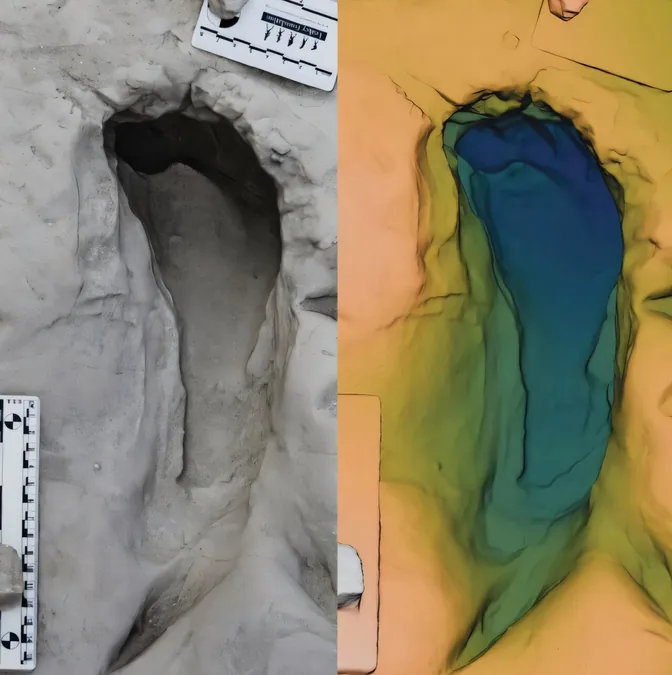
Stunning Discovery: Fossilized Footprints Reveal Two Extinct Hominin Species Coexisting 1.5 Million Years Ago!
2024-11-29
Author: Jacques
Stunning Discovery: Fossilized Footprints Reveal Two Extinct Hominin Species Coexisting 1.5 Million Years Ago!
Human footprints have always captivated our imaginations. They whisper stories of ancient lives, inviting us to ponder their journeys and intentions. Recent discoveries in eastern Africa have unveiled fossilized tracks left by our ancient relatives, providing remarkable insights into the behavior of hominin species that walked the Earth around 1.5 million years ago.
In a groundbreaking discovery, paleontologists have identified fossilized footprints of two distinct hominin species wandering the same lakeshore in Kenya—a revelation that transforms our understanding of human evolution. This findings offer a rare glimpse into the lives of Homo erectus and Paranthropus boisei, showcasing their coexistence during the same period.
The Footprints That Changed Everything
The first footprints were found by chance in 1978 near Lake Turkana, during a geological excavation led by paleontologist Behrensmeyer and paleoecologist Léo Laporte. To everyone’s astonishment, the team uncovered what appeared to be human-like prints nestled among deep hippo tracks. This serendipitous discovery left researchers in awe as they connected with a moment from 1.5 million years ago.
Fast forward to 2021 when paleontologist Louise Leakey and her team uncovered another ancient trackway nearby. Their findings suggest that the footprints were made not only in close proximity to each other but within a narrow timeframe—possibly within hours or even minutes. This milestone evidence challenges previous assumptions about human ancestry, confirming that Homo erectus and Paranthropus boisei roamed the same territory, intertwining their existences.
A Rare Glimpse into Ancient Behavior
The study of these ancient tracks provides vivid insights that fossilized bones alone cannot convey. The footprints reveal behavioral patterns, locomotion, and even interactions of these early hominins. Notably, analysis suggests that the footprints were left on a muddy surface before it deteriorated, indicating a remarkably short window for preservation.
What makes this discovery extraordinary is the interaction between these two species; they were part of a rich ecosystem that included giant birds, antelope, zebra, hippos, and elephants. This thriving community raised questions: What were they doing? Were they foraging for food along the lakeshore, which was ripe with plants and probably water sources?
What Were They Eating?
Paleontologists believe that dietary preferences might have differentiated these species even further. Paranthropus boisei might have thrived on grasses and reeds, as indicated by chemical analyses of their teeth, while Homo erectus exhibited a more varied diet that included both plant life and animal protein. The lakeshore habitat offered abundant resources, but also potential dangers, including predatory crocodiles and aggressive hippos.
Unlocking the Past: Future Excavations and Education
As researchers continue to explore these discoveries, hopes run high for further excavations that may yield more insights into this ancient community. The footprints not only provide clues to their behavior but may help scientists understand how these hominins interacted with each other and their environment over the centuries.
In a bid to share this treasure trove of history, a new museum dedicated to these renowned trackways is set to open in January 2025 near Ileret, Kenya. This initiative seeks to merge education, tourism, and community engagement, inviting locals and visitors alike to learn about the remarkable story of our ancient relatives preserved beneath their feet.
With each footprint, we come closer to unveiling the complex tapestry of human evolution, reminding us of the enduring connection we share with our ancient ancestors. This discovery is more than just fossilized impressions in the mud; it is a testament to the rich narrative of life that existed long before us. Stay tuned as we continue to unravel the mysteries of our past!









 Brasil (PT)
Brasil (PT)
 Canada (EN)
Canada (EN)
 Chile (ES)
Chile (ES)
 España (ES)
España (ES)
 France (FR)
France (FR)
 Hong Kong (EN)
Hong Kong (EN)
 Italia (IT)
Italia (IT)
 日本 (JA)
日本 (JA)
 Magyarország (HU)
Magyarország (HU)
 Norge (NO)
Norge (NO)
 Polska (PL)
Polska (PL)
 Schweiz (DE)
Schweiz (DE)
 Singapore (EN)
Singapore (EN)
 Sverige (SV)
Sverige (SV)
 Suomi (FI)
Suomi (FI)
 Türkiye (TR)
Türkiye (TR)